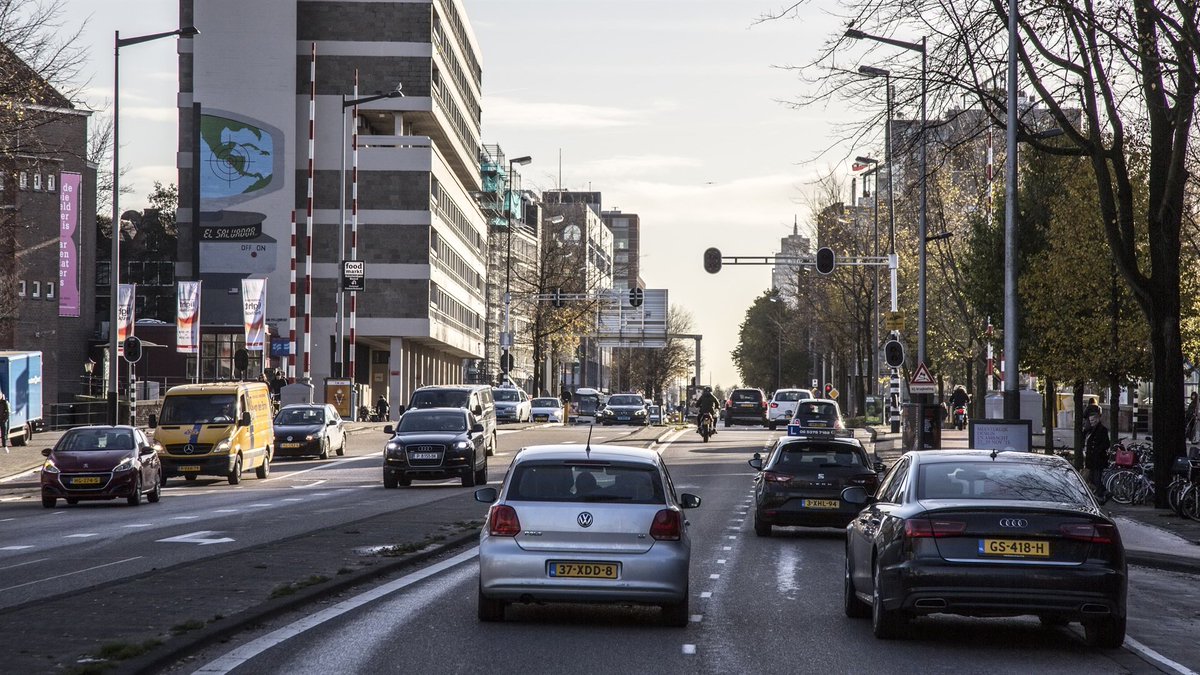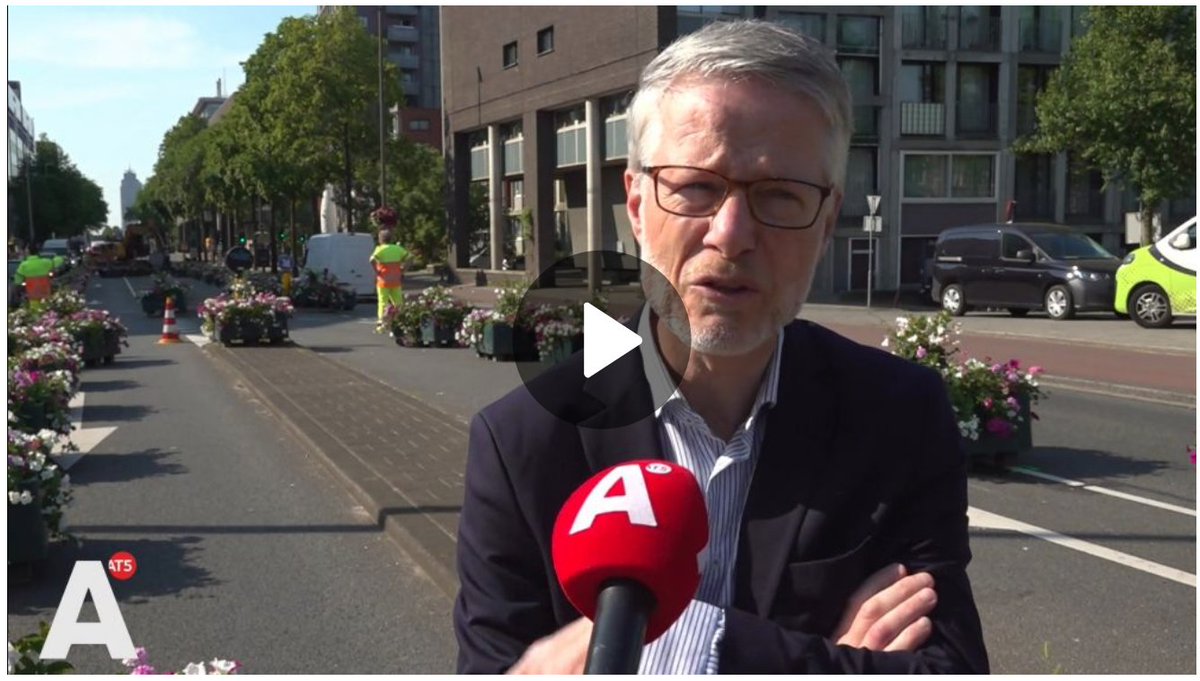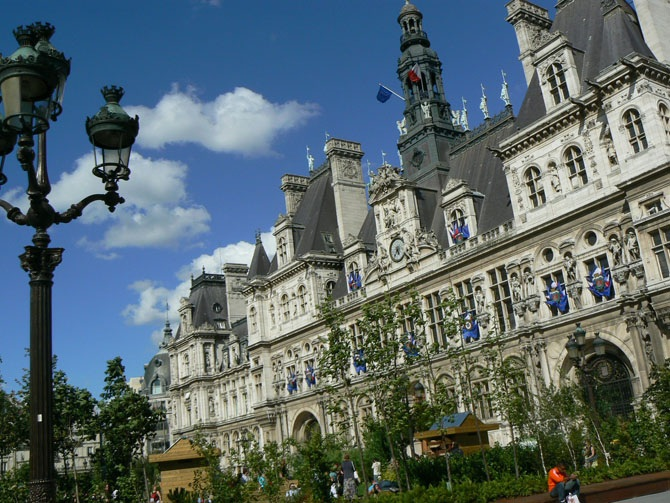Today #Amsterdam starts a transition experiment of 6 weeks that reclaims a car dominated street as public space.
There are already some important lessons about the importance of language. 1/🧵
There are already some important lessons about the importance of language. 1/🧵

The Weesperstraat has been seen as important link for car traffic to get in and out central Amsterdam for four decades.
Businesses fear for their accessibility & refer to the street as 'an artery'. Invoking the classic metaphor of cities as bodies, car traffic as blood . 2/🧵
Businesses fear for their accessibility & refer to the street as 'an artery'. Invoking the classic metaphor of cities as bodies, car traffic as blood . 2/🧵

This blinds us to why and how cities have always functioned as places for human interaction.
Instead of continuous pumping, a good city street constantly entices you to slow down, stop and linger to enjoy the public life around you.
3/🧵
Instead of continuous pumping, a good city street constantly entices you to slow down, stop and linger to enjoy the public life around you.
3/🧵

Choosing to use the solidified language of traffic engineering to launch this experiment excludes many people and a diversity of important societal challenges: autonomy of children, rights of elderly, climate adaptation or loneliness.
Instead, we hear the status quo. 4/🧵
Instead, we hear the status quo. 4/🧵

All status quo parties refer to the experiment as a 'cut' of the urban mobility system. But then we forget that the actual 'cut' was made in the 1970s.
Before activists stopped it, planners demolished the Jewish neighbourhood (Weesperbuurt) for the Modern City. 5/🧵
Before activists stopped it, planners demolished the Jewish neighbourhood (Weesperbuurt) for the Modern City. 5/🧵

Instead of 'cutting' the mobility system, we are facing the wounds that were made 50 years ago.
We are not CUTTING roads, we are STITCHING neighbourhoods.
This is what the Weesperstraat once looked like!
6/🧵

We are not CUTTING roads, we are STITCHING neighbourhoods.
This is what the Weesperstraat once looked like!
6/🧵


Academic studies show a clear and consistent outcome of these kinds of interventions.
Unlike model projections and unlike the limited imagination of the status quo, 'traffic hell' does not materialize. Instead, traffic evaporates.
Traffic is not like WATER,
but like GAS.
7/🧵
Unlike model projections and unlike the limited imagination of the status quo, 'traffic hell' does not materialize. Instead, traffic evaporates.
Traffic is not like WATER,
but like GAS.
7/🧵

And think of air quality, noise reduction, stress relieve, safety effects, children's freedom, green space effects that will benefit the silent majority!
So, when will we learn to escape the limits of the language that created the problems?
Road not CLOSED,...👇
8/🧵
So, when will we learn to escape the limits of the language that created the problems?
Road not CLOSED,...👇
8/🧵

Need more inspiration?
📕 Check out the free PDF on 'Mobility Language Matters':
decorrespondent.fetchapp.com/files/3471a7d9
📗 Read Movement with @Tverka: blackwells.co.uk/bookshop/produ…
9/🧵
📕 Check out the free PDF on 'Mobility Language Matters':
decorrespondent.fetchapp.com/files/3471a7d9
📗 Read Movement with @Tverka: blackwells.co.uk/bookshop/produ…
9/🧵
Day 2. The traffic chaos expected by some didn't materialize according to @ANWB. A bit more traffic on alternative corridors, but no effect on the ring road.
11/🧵
11/🧵

The peace and quiet at one of the squares along the corridor is striking.
12/🧵
~Jonas Daniël Meijerplein by @zeeger:
12/🧵
~Jonas Daniël Meijerplein by @zeeger:
Day 3: The alarmist @AT5 liveblog is gone.
And citizens slowly start giving meaning to this newly found public space (and cleaner air). The local Athletics evening practice!
14/🧵
And citizens slowly start giving meaning to this newly found public space (and cleaner air). The local Athletics evening practice!
14/🧵

Day 4: We are shifting away from the traffic conversation (the expected doom didnt occur).
"It is so green & cool here"
"It is so quiet here, I really had to get used to that"
"It is so nice that the traffic is gone. I hope it stays like this"
15/🧵 at5.nl/artikelen/2210…
"It is so green & cool here"
"It is so quiet here, I really had to get used to that"
"It is so nice that the traffic is gone. I hope it stays like this"
15/🧵 at5.nl/artikelen/2210…
'Make the closure permanent and in a year from now we will all be happier.'
'Do we choose luxury or liveability?'
'Make the street into one big park.'
Reader responses on Day 4 in @Parool:
16/🧵
parool.nl/de-autoluwe-st…
'Do we choose luxury or liveability?'
'Make the street into one big park.'
Reader responses on Day 4 in @Parool:
16/🧵
parool.nl/de-autoluwe-st…
Hulde aan degene die het lef kregen.
Dit is niet zomaar iets, besef even.
Hoe concretiseer je voor de omgeving het beste leven
Door te vertragen, te plaatsen, door ze te laten ademen.
Onthaasten.
- @AttaDeTolk over de #Weesperstraat (deel 1)
17/🧵
Dit is niet zomaar iets, besef even.
Hoe concretiseer je voor de omgeving het beste leven
Door te vertragen, te plaatsen, door ze te laten ademen.
Onthaasten.
- @AttaDeTolk over de #Weesperstraat (deel 1)
17/🧵
Duizenden voertuigen maken een stadsstraat overstuur
Hoezeer wordt dat meer geaccepteerd dan respect voor de natuur.
Er zal veel op ons afkomen.
Maar we stonden er niet zomaar bij, maar hebben een stap genomen.
- @AttaDeTolk over de #Weesperstraat (deel 2)
Hoezeer wordt dat meer geaccepteerd dan respect voor de natuur.
Er zal veel op ons afkomen.
Maar we stonden er niet zomaar bij, maar hebben een stap genomen.
- @AttaDeTolk over de #Weesperstraat (deel 2)
@AttadeTolk @threadreaderapp unroll
• • •
Missing some Tweet in this thread? You can try to
force a refresh

























